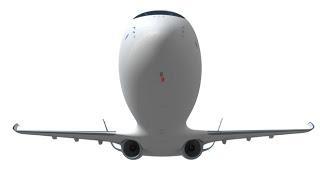 Would you get on a plane without a pilot? That may seem like a ridiculous question, but plans are already in the works to make such a thing possible. The average leisure traveler utilizes internet search engines to locate the absolute lowest price on airfare and will chose one airline over another to save a single dollar. The cheapest ticket may include the inconvenience of multiple flights and lengthy layovers, but cheap is what people want and the airlines want your business. The question is...how far will you go to save a buck and what will you do if the cheapest ticket doesn't come with a pilot?
Would you get on a plane without a pilot? That may seem like a ridiculous question, but plans are already in the works to make such a thing possible. The average leisure traveler utilizes internet search engines to locate the absolute lowest price on airfare and will chose one airline over another to save a single dollar. The cheapest ticket may include the inconvenience of multiple flights and lengthy layovers, but cheap is what people want and the airlines want your business. The question is...how far will you go to save a buck and what will you do if the cheapest ticket doesn't come with a pilot? In the past 12 years, 22 airlines have filed for Chapter 11 bankruptcy protection in the United States, 10 of which either ceased operations or were merged into other carriers. The main objective during any bankruptcy is to reduce costs and restructure a company into a money making machine, so it should be no surprise that removing pilot costs from the equation may be an attractive alternative. Most airlines report employee related expenses as the second highest cost after fuel, and since pilots are typically the highest paid workers on the property, their salaries are a big target.
Airlines internally publish a list of priorities by which it expects to operate. Each airline's list varies a little from the next, but safety is always on top followed by passenger comfort, schedule and finally operational economics...roughly in that order. I don't believe it could ever be argued that an airplane is safer without a pilot in the cockpit. I also don't think you could argue that passengers would be more comfortable or that an airline's on-time record would improve without pilots in the cockpit. So the real driving force for removing pilots from the equation has to come down to cost and whether it is cost effective to replace pilots with computers. I suspect there will be...if there isn't already...a formula similar to the one used by most product manufacturers that will consider cost reductions as a result of removing pilots while factoring in "acceptable losses" associated with potential accidents and ensuing lawsuits. It's a numbers game.
RyanAir CEO Michael O'Leary was quoted in a 2010 interview asking "Why does every plane have two pilots?" "Really, you only need one pilot. Let's take out the second pilot. Let the bloody computer fly it." And if the captain is incapacitated? Train one of the cabin crew members to land the plane, O'Leary said. "If the pilot has an emergency, he rings the bell, he calls her in." Of course, Mr. O'Leary might want to discuss this plan with the then CEO of Northwest Airlines who, during the company's 2005 bankruptcy described flight attendants like this..."I don't know why a settlement is taking so long, they are asking for too many demands considering they are a bunch of overpaid vending machines." Yikes!
James Albaugh, the president and CEO of Boeing Commercial Airlines, took the issue with pilots a step further claiming "A pilotless airliner is going to come; it's just a question of when." "You'll see it in freighters first, over water probably, landing very close to the shore."
In case you haven't been paying attention, the process of removing pilots from the cockpit has already started. In the early days of aviation, both military and commercial airplanes were dispatched with a cockpit crew that, at a minimum, consisted of a Captain, First Officer, Engineer and Navigator. And while the responsibilities carried out by these crew members are still vitally important, computers and automated systems have largely taken over the tasks. My first job at a major airline was that of a Flight Engineer on a Boeing 727. Even back in 1999, when I told people what I did for a living they assumed I had an office and a secretary at company headquarters. Who knew some airplanes actually had three pilots? Today, Flight Engineers are almost non-existent and even some of the old airplanes that used to require a Flight Engineer have been converted to two pilot airplanes.
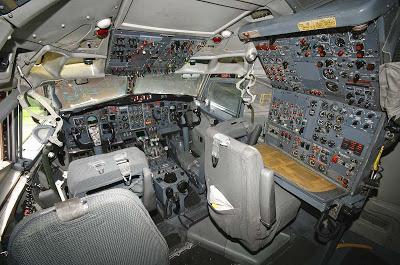
Three man cockpit of a Boeing 727
Today, I occupy the cockpit of another relic of an aging airline industry. You can read a brief history of the MD80 series aircraft in one of my previous posts, but this old bird has its roots deeply planted in the early 1960's. Today's MD80 is a far cry from the original DC-9-10 on which it is based, but the jet is still a very old design by current airline standards. Even still, the Mad Dog, as it is commonly called, is equipped with a modern autopilot that can be programmed to fly from point A to point B, land and stop on the runway with very little input from the pilot. As the old joke goes...new airplanes will be equipped with a dog and a pilot. The pilot is there to feed the dog and the dog is there to bite the pilot if he touches anything. It's funny, but it's also a little too close to reality for this old airline pilot.The MD80 hasn't quite gotten to the "dog in the cockpit" stage, and frankly even today's most modern aircraft are not as far ahead as you might think. The Flight Management System on most modern jets still needs to be loaded by a pilot...although admittedly, you don't need a pilots license to load the FMS. I am not familiar with any passenger aircraft that will takeoff automatically, but it wouldn't be that hard to design and program a system to accomplish this task as well. The landing gear does not come up or down on its own. Flaps and slats do not automatically extend or retract. I could go on. There are still many aspects of the operation that currently require human hands, but again, many of those tasks could be automated with ease.
The most significant obstacle to fully automated flight, and the reason I will never purchase a ticket on a plane without a pilot, is that automation is not and probably never will be fool proof. Last week, I was at the controls of an MD80 on a long flight to the west coast when a quiet click and flashing red light caught my attention. The auto throttles had disconnected for no apparent reason. I attempted to re-engage the automated system that controls power inputs to the engines, but the system would not operate. I suppose an airplane without pilots would have a backup, but backups fail too. For the next three hours, I had to make constant adjustments to engine power settings to ensure the aircraft maintained a safe speed that was fast enough to remain in the air, but not so fast that we used too much fuel and would not be able to reach our destination. The question begs to be answered...where would this flight have been without a pilot. Such a simple failure in such a simple system could have proved disastrous without my input.
Other emergency situations could be much worse. What if smoke began to fill the cabin? Is the smoke electrical in nature? Does it smell like burning hydraulic fluid or oil? Is it white? Black? All these questions are very important. There are multiple checklists to choose from and each is dependent on the type of smoke present. Oh by the way...on many passenger jets, the procedure for an electrical fire is going to take just about all automated systems out of the loop. Now what?
Another issue that most people do not consider is weather. Granted, ground controllers have access to accurate radar images, but as any pilot will tell you, there are lots of clouds out there that radar cannot see. Clouds that we absolutely will not fly through. Clouds that contain turbulence strong and dangerous enough to damage an airliner or injure a person who isn't seated and buckled in. I routinely ask for course deviations around weather and hear a response from Air Traffic Control that sounds something like this..."I'm not depicting anything on my radar. What are you deviating around?" The radar picture seen by ATC is a top down view of a storm that is often very different from what we see out our windows or on our own radar screens. Sometimes a storm doesn't have enough moisture to "paint" anything on the pilot's radar screen or the screen viewed by the controller. In cases like this, it is the invaluable judgment and experience of a real pilot that saves the day.
One last item I'd like to touch on is the issue of ground to air communication link failure. Pilotless aircraft are basically operated in one of two ways. Flight is either controlled autonomously by computers in the vehicle, or under the remote control of a navigator, or pilot on the ground or in another vehicle. I suspect any commercial product designed to carry human cargo will employ a combination of the two. In the worst-case scenario for a military application, if a drone is lost in battle, personnel can simply "crack another one out of the box" and have it up in the air shortly...and that's without the trauma of casualties or prisoners normally associated with an aircraft going down. I suppose that mindset won't fly for the airlines.
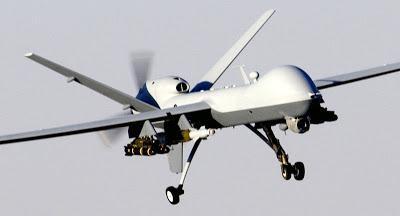
Recently, I was working a flight to Tucson, Arizona and had a pilot on the cockpit jumpseat who was an airline pilot out on military leave. We engaged in a conversation about his current duties and he explained that he was assigned to a military unit fighting daily in Afghanistan from the safety of a dark room in Tucson. He flies UAVs...Unmanned Aerial Vehicles. "Pilots fly them from trailers halfway around the world using joysticks and computer screens and go home to their wives and families at the end of the day." I asked him if the link between him and his drone is ever broken. "Oh, of course" he said. "It doesn't happen every day, but it's a problem." "Sometimes we lose contact with a drone and the darn thing just disappears. Sometimes we get them back. Sometimes we never see them again." This little piece of information leaves me wondering what would happen if the link was broken between a remote pilot and a passenger flight.
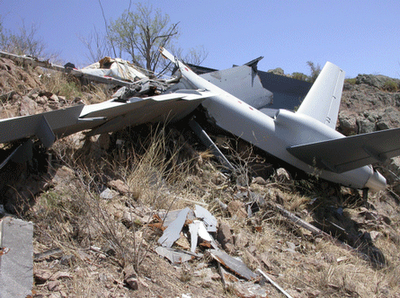
So again, I have to ask...would you get in a plane that didn't have a pilot?
A $100m program backed by the British government and involving seven European aerospace companies (AOS, BAE Systems, Cassidian, Cobham, QinetiQ, Rolls-Royce and Thales) is planning to launch a Jetstream 31 designed to test technologies and procedures that will allow commercial aircraft to operate safely and routinely without pilots. The tests are part of a long-term research project called Astraea – a name which stands for Autonomous Systems Technology Related Airborne Evaluation Assessment. The trials will include “the world’s first use of autonomous, vision-based weather-avoidance routing and the first UK surrogate flight of a fully functional visual sense-and-avoid system which includes collision avoidance tests using a second aircraft."
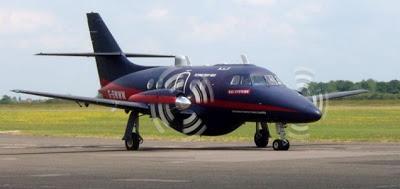
JetStream 31 test bed for the Astraea program.
It sounds like the future of pilotless planes is real. America’s aviation regulators have been asked by Congress to integrate unmanned aircraft into the skies by 2015. Will you be on board?
